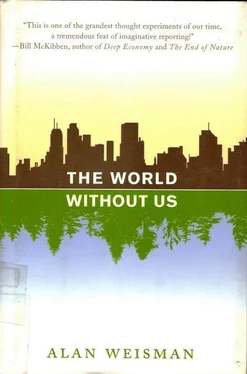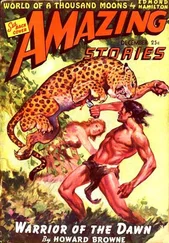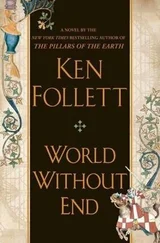How can we even contemplate a world without us? Fantasies of space aliens with death rays are, well, fantasies. To imagine our big, overwhelming civilization really ending—and ending up forgotten under layers of dirt and earthworms—is as hard for us as picturing the edge of the universe.
The Maya, however, were real. Their world had seemed destined to thrive forever, and, at its zenith, it was far more entrenched than ours. For at least 1,600 years, about 6 million Maya lived in what in some ways resembled southern California—a flourishing megalopolis of city-states, with few breaks between overlapping suburbs across a lowland that today comprises northern Guatemala, Belize, and Mexico’s Yucatan Peninsula. Their commanding architecture, and their astronomy, mathematics, and literature, would have humbled the achievements of contemporaries in Europe. Equally striking, and far less understood, is how so many could inhabit a tropical rain forest. For centuries, they raised their food and families in the same fragile environment that today is quickly being devastated by relatively few hungry squatters.
What has baffled archaeologists even more, however, is the Maya’s spectacular, sudden collapse. Beginning in the eighth century AD, within just 100 years lowland Mayan civilization vanished. In most of the Yucatan, only scattered remnants of the population remained. Northern Guatemala’s Petén province was virtually a world without people. Rainforest vegetation soon overran the ball courts and plazas, enshrouding tall pyramids. Not for 1,000 years would the world again be aware of their existence.
But the Earth holds ghosts, even of entire nations. Archaeologist Arthur Demarest, a stocky, thick-moustached Louisiana Cajun, declined a Harvard chair because Vanderbilt offered him a chance to exhume this one. During his graduate fieldwork in El Salvador, Demarest raced to salvage a bit of the ancient record from a forthcoming dam that displaced thousands, converting many of them to guerrillas. When three of his workers were accused of being terrorists, he pleaded to officials who let them go, but they were assassinated anyway.
In his first years in Guatemala, guerrillas and the army stalked each other within a few kilometers of his digs, catching in their crossfire people who still speak languages derived from the hieroglyphics his team was decoding.
“Indiana Jones swashbuckled through a mythical, generic Third World of swarthy people with threatening, incomprehensible ways, defeating them with American heroics and seizing their treasures,” he says, mopping his thick black hair. “He would have lasted five seconds here. Archaeology isn’t about glittery objects—it’s about their context. We’re part of the context. It’s our workers whose fields are burning, it’s their children who have malaria. We come to study ancient civilization, but we end up learning about now.”
By Coleman lantern, he writes through the humid night to the rumble of howler monkeys, piecing together how, over nearly two millennia, the Maya evolved a means of resolving discord between nations without destroying each other’s societies in the process. But then something went wrong. Famine, drought, epidemics, overpopulation, and environmental plunder have been blamed for the Maya’s downfall—yet for each, arguments exist against liquidation on such a massive scale. No relics reveal an alien invasion. Often extolled as an exemplary stable and peaceable people, the Maya seemed least likely to overreach and be devoured by their own greed.
However, in the steamy Petén, it appears that is exactly what happened—and that the path to their catastrophe seems familiar.
_____
The trek from the Riochuelo Petexbatún to Dos Pilas, the first of seven major sites that Demarest’s team uncovered, passes for hours through mosquito-rich stretches of strangler vines and palmilla thickets, then finally climbs a steep escarpment. In remaining groves still unplundered by timber poachers, giant cedars, ceibas, chicle-bearing sapodillas, mahoganies, and breadnut trees rise from the thin tropical soils capping the Petén limestone. Along the escarpment’s ragged edge, the Maya built cities that Arthur Demarest’s archaeologists have determined once formed an interlocking kingdom called Petexbatún. Today, what appear to be hills and ridges are actually pyramids and walls, built from chunks of local limestone hewn with chert adzes, now disguised by soil and a mature rain forest.
The jungle surrounding Dos Pilas, filled with clacking toucans and parrots, was so dense that after it was discovered in the 1950s, 17 years passed before anyone noticed that a nearby hill was actually a 220-foot pyramid. In fact, to the Maya, pyramids re-created mountains, and their carved monoliths, called stelae, were stone representations of trees. The dot-and-bar code glyphs carved into the stelae unearthed around Dos Pilas tell that, about AD 700, its k’uhul ajaw —divine lord—began to break the rules of restrained conflict and started usurping neighboring Petexbatún city-states.
A mossy stela shows him in full headdress, holding a shield, standing on the back of a bound human captive. Before society began unraveling, Classic Mayan wars were often keyed to astrological cycles, and at first impression they might seem singularly grisly. A male of an opposing royal family would be captured and paraded in humiliation, sometimes for years. Eventually, his heart would be ripped out, or he would be decapitated, or tortured to death—at Dos Pilas, one victim was tightly rolled and bound, and then used for a game on the ceremonial ball court until his back was broken.
“And yet,” Demarest notes, “there was relatively no societal trauma, no destruction of fields or buildings, or territories taken. The cost of Classic Mayan ritual war was minimal. It was a way of maintaining peace through constant, low-grade warfare that released tensions between leaders without endangering the landscape.”
The landscape was a working equilibrium between wilderness and artifice. On hillsides, Mayan walls of tightly packed cobbles trapped rich humus from runoff water for cultivation terraces, now lost beneath a millennium of alluvium. Along lakes and rivers, Mayas dug ditches to drain swamps, and by heaping the soil they removed, they created fertile raised fields. Mostly, though, they mimicked the rain forest, providing layered shade for diverse crops. Rows of corn and beans would shelter a ground cover of melons and squash; fruit trees, in turn, shielded them, and protective patches of the forest itself would be left among fields. Partly, it was a happy accident: without chain saws, they had to leave the biggest trees.
That is exactly what hasn’t happened in nearby modern squatter villages, along logging roads where flatbed trailers carry away cedar and mahogany. The settlers, Mayan-Kekchi-speaking refugees from the highlands, fled counterinsurgency attacks that killed thousands of Guatemalan peasants during the 1980s. Because slash-and-burn rotations used in volcanic mountains prove calamitous in rain forests, these people were soon surrounded by expanding wastelands yielding only stunted ears of maize. To keep them from looting all his sites, Demarest budgets for doctors and jobs for locals.
The Maya’s political and agricultural system functioned for centuries throughout the lowlands, until it began to break down at Dos Pilas. During the eighth century, new stelae began appearing, with the creative flair of individual sculptors supplanted by uniform, military social realism. Gaudy hieroglyphics incised on each tier of an elaborate temple staircase record victories over Tikal and other centers, whose glyphs were replaced by those of Dos Pilas. For the first time, land was being conquered.
Читать дальше











